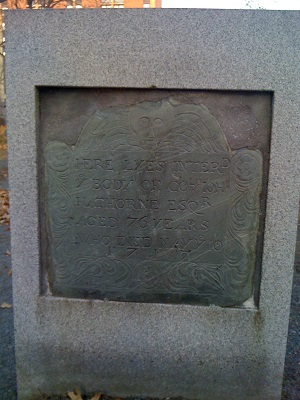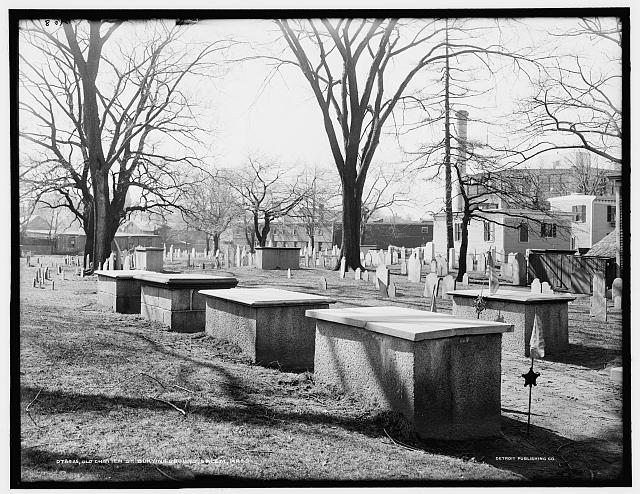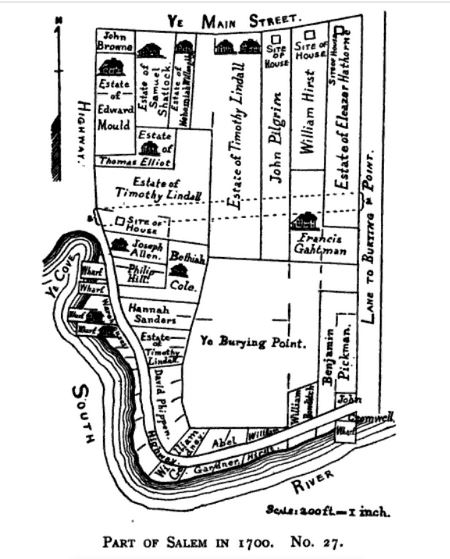Established in 1637, the Old Burying Point Cemetery, also known as the Charter Street Cemetery, is the oldest cemetery in Salem, Massachusetts. It is one of eight historic cemeteries in Salem and is a stop on the Salem Heritage Trail.
The cemetery is 1.47 acres in size and contains 700 headstones and 17 box tombs dating back to the 17th, 18th and 19th centuries.
Most of the headstones are made out of slate but some are also made out of sandstone, schist and marble. The cemetery was never paved and still has dirt paths that weave in between the various plots.
Old Burying Point Cemetery History:
The cemetery didn’t have an official name when it was first established and was mostly called ye burying place up until 1667 when locals started calling it ye common as well as ye burying place.
The cemetery was also much smaller when it was first established and consisted only of what is now the southwest corner of the cemetery, which includes the section along Derby Street.
Burials prior to 1673 were marked with wooden grave markers, often called Coffin Posts or Coffin Rails, which have since deteriorated and no longer exist.
In 1673, the oldest existing gravestone in the cemetery, the Cromwell stone, was placed when Doraty Cromwell passed away on September 27, 1673 at the age of 67.
In 1668, the cemetery was expanded when the town purchased what is now the northern section of the cemetery from Henry Bartholomew and also purchased a small strip of land next to the cemetery from Edward Grove for 20 pounds.
In 1767, after Charter Street was established, the cemetery was expanded again when two lots owned by William Lander and Joseph Mottey, (marked as John Pilgrim and Timothy Lindall’s estates on the 1700-era map), which were located between the newly established Charter Street and the cemetery grounds, were purchased by the town on June 13 of that year (Essex Antiquarian 68.)
In 1669, locals began calling the cemetery the common burying place and, in 1679, began calling it ye burying point. At the time, the South River surrounded the cemetery on two sides, which is why the cemetery was referred to as a point.
In 1794, locals began calling the cemetery the point burying place and a street leading past the cemetery, now known as Liberty Street, was referred to at the time as Burying Place Lane or Burying Point Lane until 1795 when it was officially named Liberty Street (Essex Antiquarian 66.)
The last burial took place in the cemetery in 1894 when Horace Lorenzo Ingersoll was buried in a box tomb in September of 1894.
Since then, many of the headstones have been damaged and weathered over the years and have been repaired and reset.

In 2019, the City of Salem began a restoration project to restore 23 headstones and 8 box tombs.
Notable People Buried in the Cemetery:
Many notable people are buried in the cemetery. Some of these people have connections to the Salem Witch Trials while others have connections to other important events in Massachusetts history:
Nathaniel Mather, son of Increase Mather and brother of Cotton Mather, died in 1688, buried in the far right of the cemetery near the fence next to the Grimshawe House.
Judge John Hawthorne, Salem Witch Trials judge, died in 1717, headstone has been placed in a granite block to preserve it and is located on the left side of the cemetery

Judge Bartholomew Gedney, Salem Witch Trials judge, died in 1698, buried in a red sandstone box tomb about 60 feet from the front gate
Mary Corey, second wife of accused witch Giles Corey, died in 1684, buried towards the back of the cemetery on the left side.
Captain Richard More, Mayflower passenger, died in 1694, buried near Hathorne’s grave
Governor Simon Bradstreet, died in 1697, was buried in the Bradstreet tomb but it is believed his remains were removed when the tomb was sold to the Hathorne-Ingersoll family
Reverend John Higginson, died 1718
Chief Justice Benjamin Lynde, died 1745, buried in a box tomb
Samuel McIntire, local architect, died in 1811
Reverend Nicholas Noyes, assistant minister during the Salem Witch Trials, died in 1718, believed to have been buried in an unmarked grave somewhere in the cemetery

Samuel Shattuck Jr, young son of Shattuck family who accused Bridget Bishop of bewitching him and making him ill, died in 1695 at age 17, and is buried towards the front of the cemetery
Contrary to popular belief, none of the convicted Salem witches were buried in this cemetery because convicted witches were not allowed a Christian burial. It is now known exactly what happened to their bodies but a few family legends suggests that some of their bodies were claimed by their families and buried on their private property.
Houses and Structures Next to the Cemetery:
The cemetery is located within the Charter Street Historic District and is next door to a few historic houses and a memorial:
Salem Witch Trials Memorial, a memorial dedicated to the victims of the Salem Witch Trials located at 24 Liberty Street.
Grimshawe House, a historic Federal-style house located at 53 Charter Street.
Pickman House, a historic first period house located at 165 Essex Street that is now owned by the Peabody Essex Museum but is closed to the public.
Pin it for later:
Sources:
Perley, Sidney. “Salem in 1700.” Essex Antiquarian.Vol XI, Edited by Sidney Perley, 1907
“Salem Tales – Charter Street.” Salemweb.com, salemweb.com/tales/charter.php
“Charter Street Cemetery.” Preserving Salem, preservingsalem.com/charter-street-burial-ground
“Charter Street Cemetery: Frequently Asked Questions.” Salem.com, salem.com/home/news/charter-street-cemetery-frequently-asked-questions



